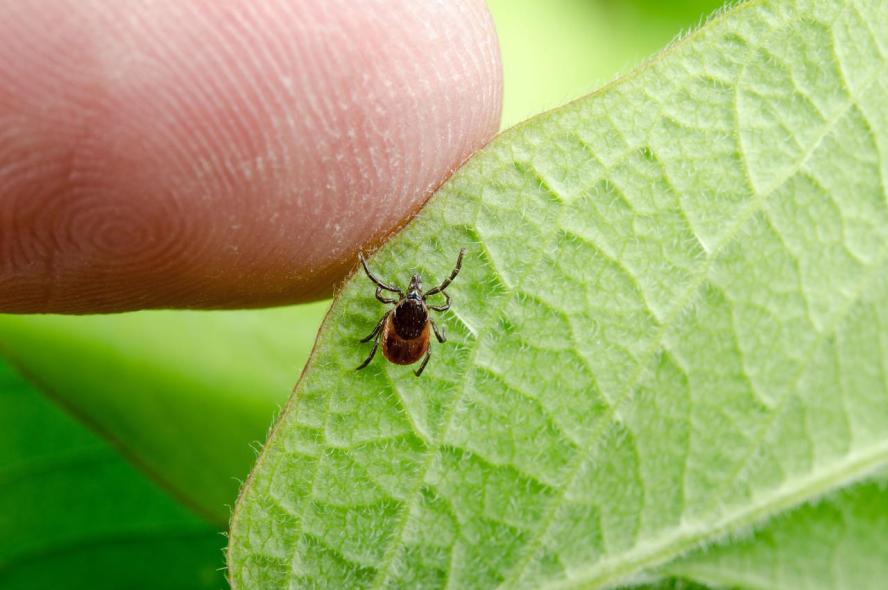-
About
- Departments & Offices
-
Academics
- Public Health
- Biomedical Sciences
- Physician Assistant
- Special Master’s (MBS)
-
Admissions & Financial Aid
- Tuition & Fees
-
Student Experience
-
- Student Resources by Program
- Academic & Student Support
- Wellness & Wellbeing
- Student Life
- Events & Traditions
-
-
Research
- Research Labs & Centers
- Tufts University-Tufts Medicine Research Enterprise
-
Local & Global Engagement
- Global Health Programs
- Community Engagement
What Works for Dogs May Work for Us: A Promising Breakthrough in Lyme Disease Prevention
A new clinical trial shows a treatment's potential to proactively eliminate ticks before transmission.

In the ongoing battle against Lyme disease, recent collaborative efforts between academia and pharmaceutical companies have yielded a promising breakthrough. Tarsus Pharmaceuticals teamed up with Tufts University School of Medicine and Tufts Medical Center to conduct a phase two clinical trial of their drug candidate TP-05, an oral systemic formulation of lotilaner. “Lotilaner has been available for dogs for a long time, but no one has thought to develop innovative formulations to potentially prevent Lyme disease in humans before this,” explains Linden Hu, the Paul and Elaine Chervinsky Professor in Immunology at the Tufts University School of Medicine.
Hu led the clinical trial that brought together collaborators Sam Telford, professor of infectious diseases and global health at the Cummings School of Veterinary Medicine, and Yoav Golan, director of the Clinical and Translational Research Center (CTRC) at Tufts Clinical and Translational Science Institute (CTSI).
Previously, Hu worked with Telford and Adriana Marques, the chief of the Lyme Disease Studies Unit at the National Institute of Health, to develop a unique system for cultivating ”clean” ticks, free of organisms that infect humans, that could be safely applied to subjects. Leveraging this unique model, Tarsus and Hu designed a clinical trial to evaluate the efficacy of TP-05 in eradicating ticks.
During the trial, 31 healthy adults were administered either a low or high dose of lotilaner, or a placebo. Researchers placed sterile ticks on the participants’ arms, allowed them to attach and then gave them a dose of drug or placebo. Tick death was assessed at 8 and 24 hrs. The results revealed that on the first day, 97 percent of ticks in the high-dose group and 92 percent in the low-dose group had perished, whereas only 5 percent of ticks in the placebo group met the same fate. Protection from the drug appears to be long lasting. When ticks were placed on subjects again after one month, the researchers found that both doses of the tablet exhibited a tick mortality rate of around 90 percent.
“Because it typically takes greater than 48 hours of feeding to transmit the Lyme bacteria, killing ticks early is likely to prevent Lyme disease,” explains Hu. “The quick onset of action within hours means that the drug could potentially be taken right before a risky activity; the long period the drug remains active may mean that people who are exposed to risk continually may only need to take it two or three times a year.”
“A potential benefit of lotilaner is that, compared with vaccines that only prevent one disease, killing ticks may also prevent transmission of two or more tick transmitted diseases, including babesiosis and anaplasmosis for example, which also require that the ticks feed for days before the infection can be passed,” said Telford.
The implementation of the drug trial was achieved through a partnership with the Tufts CTRC, which provides all required services and support for clinical studies and trials, such as outpatient and inpatient facilities at Tufts Medical Center, specialized research nurses, study drug administration, and recruitment and retention of study participants.
“Tufts CTRC is proud to be part of this milestone trial,” remarked Golan, who is also an associate professor of medicine at the School of Medicine. “The full repertoire of clinical research services provided by the Tufts CTRC, together with the expertise and experience of Dr. Hu and the Tufts School of Medicine team, has led to the successful completion of this landmark trial. Tufts CTRC continues to expand collaborations with the medical school as well as other Tufts affiliated institutions.”
Unlike traditional antibiotic treatments that target bacterial infections post-exposure, these results show that lotilaner could potentially be taken proactively to eliminate ticks before transmission occurs. In most cases, ticks must be attached for about 36-48 hours or more before Lyme disease can be transmitted, so quickly killing ticks can significantly increase the probability of disease prevention.
While these initial results are promising, further research is warranted to validate TP-05's efficacy in preventing Lyme disease. Large-scale field trials involving participants at high risk of exposure to Lyme could confirm its effectiveness. But, as the research progresses, the prospect of a future where effective prevention measures safeguard public health against tick-borne diseases grows increasingly tangible.
Department:
Immunology